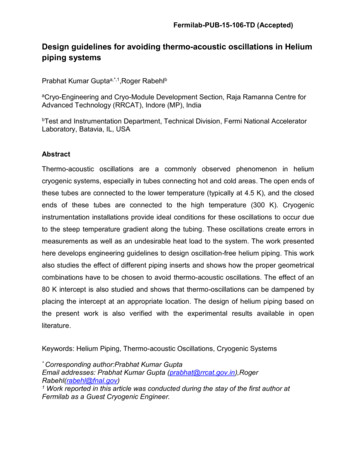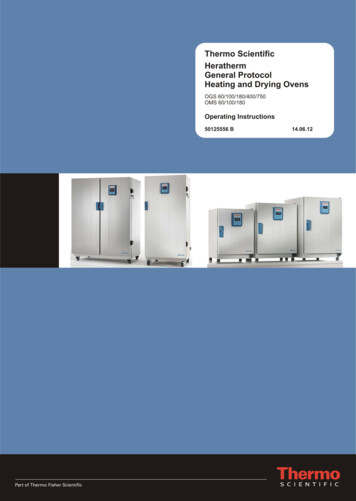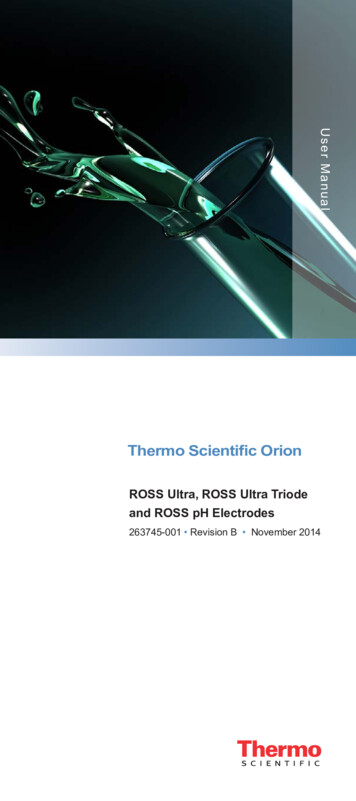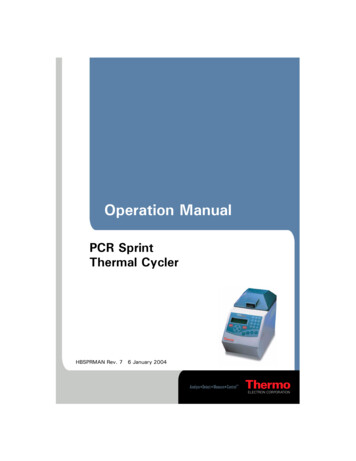
Transcription
Fermilab-PUB-15-106-TD (Accepted)Design guidelines for avoiding thermo-acoustic oscillations in Heliumpiping systemsPrabhat Kumar Guptaa,*,1,Roger RabehlbaCryo-Engineeringand Cryo-Module Development Section, Raja Ramanna Centre forAdvanced Technology (RRCAT), Indore (MP), IndiabTestand Instrumentation Department, Technical Division, Fermi National AcceleratorLaboratory, Batavia, IL, USAAbstractThermo-acoustic oscillations are a commonly observed phenomenon in heliumcryogenic systems, especially in tubes connecting hot and cold areas. The open ends ofthese tubes are connected to the lower temperature (typically at 4.5 K), and the closedends of these tubes are connected to the high temperature (300 K). Cryogenicinstrumentation installations provide ideal conditions for these oscillations to occur dueto the steep temperature gradient along the tubing. These oscillations create errors inmeasurements as well as an undesirable heat load to the system. The work presentedhere develops engineering guidelines to design oscillation-free helium piping. This workalso studies the effect of different piping inserts and shows how the proper geometricalcombinations have to be chosen to avoid thermo-acoustic oscillations. The effect of an80 K intercept is also studied and shows that thermo-oscillations can be dampened byplacing the intercept at an appropriate location. The design of helium piping based onthe present work is also verified with the experimental results available in openliterature.Keywords: Helium Piping, Thermo-acoustic Oscillations, Cryogenic Systems* Correspondingauthor:Prabhat Kumar GuptaEmail addresses: Prabhat Kumar Gupta )1 Work reported in this article was conducted during the stay of the first author atFermilab as a Guest Cryogenic Engineer.
1. IntroductionCryogenic systems are very susceptible to thermal-oscillation instabilities. When a gascolumn in a long cylindrical tube is subjected to strong temperature gradients, it mayspontaneously oscillate with large amplitudes. These thermo-oscillations are generallycalled Taconis oscillations. These Taconis oscillations are most problematic in heliumcryogenic systems where one end of a tube is at liquid helium temperature and otherend of the tube is at ambient temperature. These oscillations can result in an enormousheat flux at the cold end, up to 1000 times greater than the tube conduction itself [1].Rott [2] successfully generated the stability curves for oscillations in helium systems,predicting the oscillating and non-oscillating zones. Rott discovered that there are twobranches of the curve, a lower branch and an upper branch. Both of these branches joinat a single point below which there are no excited oscillations. He also concluded thatthe upper branch of the stability curve does not have any practical significance becauseof the excessively high temperature ratios required. Today, these curves serve as aprimarily design criteria to identify or predict where oscillations will occur. As a reminderof Rott’s analysis, a stability curve for helium gas developed by him is reproduced in thispaper. Figure 1 shows the stability diagram developed by Rott [2]. The phase diagramgenerated by Rott has also been verified experimentally by many researchers [1, 3].Experimental verification of Rott’s stability curve done independently by Fuerst isreproduced here in Figure 2 [1]. Another experimental work for liquid helium system isreported by Youfan and Timmerhaus [4] and reproduced in Figure 3. They all concludedthat cryogenic oscillations can be predicted with reasonable accuracy with the help ofthe Rott stability curves.The stability curve generated for helium gas indicates that thermal oscillations can beavoided if proper attention is paid during the design stage. Certain combinations of tubelength and tube inner diameter will result in an oscillation-free system. Moreover, anyexisting thermal oscillations in the system can be dampened by altering the operatingtemperature ratio between the hot and cold ends by providing an 80 K intercept. Thelocation of this intercept must be chosen carefully.Different experimental and analytical work, as reproduced in this paper, has beenreported for helium cryogenics in open literature. But to the best knowledge of the
present authors, there are no clear, simple, and ready to use design guidelines existingin literature to design oscillation-free helium piping. Furthermore, it is also not straightforward to determine acceptable length-diameter combinations based on the presentavailable literature. Therefore, the present work is aimed at describing engineeringdesign guidelines for helium piping systems to avoid thermal oscillations. Stabilitylimited length and inner diameter combinations have been generated using the Rottmathematical model and verified with available experimental results in tabular form. Thepresent work is also extended to formulate the design guidelines in the presence of tubeinserts, describing how to choose acceptable length-diameter combinations to result inan oscillation-free system. The appropriate location of an 80 K intercept to dampenoscillations in a tube with one end at 300 K and the other end at 4.5 K is also analyzedas a function of tube length and inner diameter.
Figureα 1.versusStabilitycurvesforhelium,thefor given values ofhot-to-coldtemperature. Figure 3 of reference 2 isreproduced here with permission as a reminder.YcFigure 2. Experimental verification of stability curve forratio[1].
Figure 3. Experimental verification of stability curve, the hot-to-cold temperature ratioα versus radius r for[4]. Reprinted with permission.2. AnalysisFigure 4 shows a typical arrangement of helium piping with one end at 4.5 K and theother end at 300 K. It is assumed that the tube is filled with helium gas at 1.3 barabsolute pressure corresponding to 4.5 K saturated temperature. The helium gascolumn confined in the tube is assumed to be oscillating.
300 K, 4.5 KFigure 4. Typical example of a helium piping system.According to Rott’s theory, the optimum position of the temperature jump (temperaturerise from cold end temperature to hot end temperature) for excited oscillations lies nearthe middle of the half-open tube and remains practically unaffected up to a hot-to-coldlength ratio of 2:1. Therefore, the present analysis is based on the assumption that thistemperature jump occurs at the center of the tube as shown in Figure 5. From a closerlook at the Rott stability curves, it can also be said that assuming this temperature jumpoccurs at the centerwill always produce conservative design criteria for giventemperature ratios. Figure 1 gives the maximum value of Yc (outer most curve) for 1 and for given value of. Maximum value of Yc will always result in minimum criticaldiameter of tube for a given length for oscillation free tube sizing.To illustrate the position of this temperature jump mathematically, it can be seen fromFigure 5 that at x 0, the tube is open and the temperature can rise to the hot endtemperature over a very small portion of the tube ( x l ) near its center. Therefore itcan be assumed that the helium gas will have a constant temperature TL between x 0
and x l. At x L, the tube will be closed and it will be at constant temperature THbetween x l and x L. The position of the temperature jump can be givenmathematically as the ratio of hot end tube length to cold end tube length and can beexpressed as(1)In the present analysis, a constant ξ 1 is used by assuming the temperature jumpoccurs at the center.Figure 5. Illustration of temperature distribution along the tube.The goal of this document is to develop an analysis and useful guidelines which can bedirectly applied to the practical purpose of designing oscillation-free helium pipingsystems or damping out oscillations in existing helium piping systems. The lower branchof the Rott stability curve is used for the analysis, and this stability curve is generatedusing the Equation 18 from Ref. [2](2)
whereis the hot-to-cold temperature ratio expressed as(3)The value ofin Eq. (2) is given by(4)where ω is the angular frequency, ac is the sound speed in the gas at cold end, and l isthe tube cold length.The value λc is varied from 0.8 to 1.4 for ξ 1 and can beapproximated to 1 for calculation.According to Rott’s analysis D is a constant and the exponent β is strongly dependenton the intermolecular force field and can be set to an empirical constant for helium overthe temperature range of 300-4.5 K. These constants values used in Eq.(2) are D 1.19[2], β 0.647 [2] for helium, andξ 1.0 as discussed earlier. The stability curvegenerated from Eq. (2) for ξ 1.0 is shown in Figure 6.The stability limit Yc calculated from Eq. (2) is in excellent agreement with numericalvalues plotted in Figure 6 of Ref. [2]. Therefore Eq. (2) can be directly used to get thestability limit for different temperature ratios α.The physical phenomena underlying the driving potentials of thermo-acousticoscillations in tubes depend on the viscous action of the fluid on the tube surfaces.Thermo-physical properties of the fluid and geometric parameters of the tube, such aslength and inner diameter, play a crucial role propagating or damping these oscillations.To represent this physical phenomena Rott has introduced a parameter Yc , ratio of tubeinner radius to Stokes boundary layer thickness. This parameter controls the amplitudeof a Taconis oscillation and is given by
(5)where do is the tube inner diameter andis the kinematic viscosity of the fluid.Figure 6. Lower stability curve from Eq.(2).The dimensionless parameter Yc for stability given in Eq.(5) is a numerical solutionderived in reference 2 in terms of Yc for the same physical phenomena and can bedirectly compared to Eq. (2) in order to set the critical limit of tube inner diameter for agiven tube length and temperature ratio. Therefore(6)(7)
The critical tube inner diameter given by Eq.(7) is an important parameter. Its practicalsignificance and how it is useful in the piping design will be discussed in the upcomingsection of this report.The present analysis also studied the effect of inserts in the tube. If the insert diameteris di, Eq.(7) can be modified as follows(8)where.3. Results and DiscussionBased on the analysis presented in the above section, occurrence of thermo-acousticoscillations for different tube length-diameter combinations can be mapped. Thismapping can be directly applied by the designer for choosing a tube length-diametercombination so that the system will be oscillation-free. Figure 7 shows such a mappingdiagram for different length-diameter combinations of practical interest.Figure 7 displays the results for two cases. In the first case, one end of the tube is at300 K and the other end is at liquid helium temperature ( 4.5 K). In the second case,one end of the tube is at 80 K and the other end is at liquid helium temperature ( 4.5 K).This figure shows two zones, oscillating and non-oscillating, for certain length-diametercombinations of the tube. One can quickly find from Figure 7 which length-diametercombinations will fall in the oscillating zone. For example, if one selects a 1 m length ofinstrumentation tubing to be connected between 300 K and 4.5 K, then a tube innerdiameter greater than 28 mm is required to ensure the helium piping will be oscillationfree.
Figure 7. ifferentlength-diameterIn cryogenic instrumentation piping, different kinds of inserts are used which reduce theeffective volume inside the piping. Examples of common inserts are copper wires andnylon fish lines. Usage of inserts should be considered during piping design. Figure rentlength-diametercombinations when tube inserts are used. It shows that the combination of tube lengthand tube inner diameter should be selected based on what percentage of the tube innerdiameter is occupied by inserts. For example, if 50% of the tube inner diameter (25% ofthe gas space cross-section in the tube) is occupied by inserts, one must select a tubeinner diameter greater than 50 mm to ensure that a 1 m long tube will be oscillationfree. If inserts occupy 80% of the tube inner diameter (64% of the gas space cross-
section in the tube), one must select a tube inner diameter greater than 140 mm toensure that the same 1 m long tube will be oscillation-free.Figure 8. Length-diameter combinations in the presence of inserts for the temperatureboundary conditions of 300 K and 4.5 K.Similarly, Figure 9 presents the selection criteria for a tube of which one end is 80 K andanother end is maintained at 4.5 K. It could be noticed from Figure 9 that tube diametercould be reduced significantly for the temperature boundary of 80 K – 4.5 K.Many cryogenic systems use the 80 K intercept to dampen the thermo-acousticoscillations. These intercepts typically are the 80 K heat sink tied to a tube. The analysisalso studied the most appropriate location of an 80 K intercept to dampen the thermoacoustic oscillations in the tube without inserts. It is assumed the warm end is at 300 Kand the cold end is at 4.5 K. For a given tubing length and inner diameter, the maximum
distance from 4.5 K (cold end) to the 80 K intercept (and therefore the minimumdistance from the 80 K intercept to 300 K) for oscillation-free operation is calculated bythe stability limit Yc 90.86. This stability limit has been calculated from Equation 2 forthe fixed temperature ratio α 17.77 ().This stability limit is the limitingfactor to determine the most appropriate location of an 80 K intercept between the hotend (300 K) and the cold end (4.5 K).Figure 9. Length-diameter combinations in the presence of inserts for the temperatureboundary conditions of 80 K and 4.5 K.Results of this analysis are shown in Figure 10. This analysis reveals some interestingfacts. Figure 10 shows that there is a maximum distance for certain inner diameters oftubes. For a 5 m long tube, the maximum distance from the cold end (4.5 K) to the 80 Kintercept is 2 m for a 4.57 mm inner diameter. If the tube inner diameter is 7.5 mm orgreater, the 80 K intercept could be placed at any position for the same total length of
tube. The results displayed in Figure 10 have been obtained by assuming that the tubeis closed at different locations from cold end and is at 80 K.Figure 10. Stability-limited maximum distance of 80 K intercepts from the cold end toavoid thermo-acoustic oscillations.4. Experimental verification of present methodResults obtained from the present method have been verified with the available resultsin open literature. The experimental results taken from elsewhere [1, 4] and graphsreproduced in the present work are used for the comparisons. The present method hasbeen verified for the 300 K – 4.5 K and 80 K -4.5 K temperature boundaries and also for80 K intercepts locations. The tube sizes have been used as used in the experimental
work done by Fuerst [1] for the comparisons. To verify these results, the stability limit Ychas been calculated from Eq.5 using geometrical parameters of tubes and heliumproperties. These data then have been compared with Figure 2 to determine whetherthey are located in the oscillation zone or not for different values of α.Similarlyexperimental values of Figure 3 have also been compared for different values of fordifferent tube diameters. These results have been tabulated in Table 1, Table 2 andTable 3. The simple method developed in the present work predicts well whetheroscillations will occur and could be used for designing oscillation-free piping.Table 1. Experimental verification of present helium piping design from the experimentalresults available in open literature [1, 4]: hot end at 300 K, cold end at 4.5 K, tubelength: 1 meterTube/pipe SizesOD 3.18 mmID1.40 mmOD 6.35 mmID4.57 mmOD 12.70 mmID 10.92 mmODID42.20 mm38.90 l datafrom Reference 1Thermo-acousticoscillationoccurrence,experimental datafrom Reference 4Predicted thermoacoustic oscillationoccurrence, datafrom the presentanalysis Figure illationsNo oscillationsNo oscillationsMinimum criticaldiameter is 28.2 mmNo oscillationsTable 2. Experimental verification of present helium piping design from the experimentalresults available in open literature [1,4]: hot end at 80 K, cold end at 4.5 K, tube length:1 meterThermo-acousticThermo-acousticPredicted thermooscillationoscillationacoustic oscillationTube Sizesoccurrence,occurrence,occurrence, dataexperimental dataexperimental datafrom the presentfrom Reference 1from Reference 4analysis Figure 7OD 3.18 mmOscillationsOscillationsOscillationsID1.40 mmOD 6.35 mmNo oscillationsNo oscillationsNo oscillationsID4.57 mmOD 12.70 mmNo oscillationsNo oscillationsNo oscillationsID 10.92 mm
Table 3. Experimental validation of location of 80 K intercept from literature [1]: tubelength is 5 meterThermo-acousticPredicted thermooscillationacoustic oscillationLocation of 80 Koccurrence,occurrence, dataTube sizeinterceptexperimental datafrom the presentfrom Reference 1analysis Figure 10No 80 K interceptOscillationsOscillations80 K intercept placedat hot end ( 300 K),now boundaryOscillationsOscillationsconditions became4.5 K – 80 K and L 5m80 K intercept placedat 3 m away fromOD 6.35 mmcold end, nowID 4.57 mmOscillationsOscillationsboundary conditionsbecame 4.5 K – 80 Kand L 3 m80 K intercept placedat 0.6 m away fromcold end, nowNo oscillationsNo oscillationsboundary conditionsbecame 4.5 K – 80 Kand L 0.6 mNo 80 K interceptOscillationsOscillations80 K intercept placedat hot end ( 300 K),now boundaryNo oscillationsNo oscillationsconditions became4.5 K – 80 K and L 5m80 K intercept placedat 2 m away fromOD 12.70 mmcold end, nowID 10.92 mmNo oscillationsNo oscillationsboundary conditionsbecame 4.5 K – 80 Kand L 2 m80 K intercept placedat 0.6 m away fromcold end, nowNo oscillationsNo oscillationsboundary conditionsbecame 4.5 K – 80 Kand L 0.6 m
5. Demonstration of application of present methodFor a helium cryostat design, the expected liquid helium filling temperature is 4.5 K.Tubing needs to be design for this cryostat of which one end is at 4.5 K and other end isat room temperature (300 K). The tubing diameter of an appropriate length shall bedetermined with and without an 80 K intercept so that there are no oscillations presentin the system.Table 4 shows the required properties of oscillating helium gas at the cold end of tube,TL 4.5 K.Table 4. Sound speed, ac, and kinematic viscosity of helium,ac ( m/s)Helium properties at TL 4.5 K and pressure, p 100.4at TL( m2 /s )6.22X10-81.3 X 105 Pa5.1.Tube sizing of 2 m length without 80 K interceptEq. 7 has to be used to determine the minimum inner tube diameter. The otherparameters which are required in Eq. 7 are:D 1.19 [2], α 300/4.5 66.67, β 0.647 [2], l 1 m for ξ 1 and λc 1.0The critical tube inner diameter. Figure 7 couldalso be directly used for determining the appropriate tubing sizing for oscillation-freedesign.
5.2.Tube sizing of 4 m length with an appropriate location of 80 K interceptA tube size of 6.35 mm OD, thickness 0.89 mm and length of 4 m has been selected forcryostat design of which one end is exposed to 4.5 K and other end is at roomtemperature, 300 K. An 80 K intercept location shall be selected for oscillation-freedesign.First Eq. 2 has to be used to determine the stability limit, Yc, for temperature boundariesof 4.5 K - 80 KEq. 5 is subsequently applied to determine the stability limit Yc . The stability limitcalculated from Eq. 5 should be more than the above calculated value to make thedesign oscillation-free.To calculate Yc from Eq. 5, let us choose the location of 80 K intercept 4 m away fromcold end (i.e. at hot end ) and thereforeforand do 6.35 – 2X0.89 4.57 mmThe value of Yc is less than the above calculated value and therefore the location of the80 K intercept will not be effective to make the design oscillation-free.Now let us choose the another location of 80 K intercept 2 m away from cold end andthereforeforand do 6.35 – 2X0.89 4.57 mm
The value of Yc is more than the above calculated value and therefore the location of 80K intercept will make the design oscillation free.6. ConclusionsThis analysis presents a simple method to size helium tubes that will be free of thermoacoustic oscillations. The presented figures can serve as a reference for determiningthe oscillating and non-oscillating zones for different tube length-diameter combinations.Design guidelines can also be obtained for sizing oscillation-free helium tubes wheninserts are used. The analysis provides useful information for an appropriate location ofan 80 K intercept to avoid thermo-acoustic oscillations and is verified against theavailable experimental results. This analysis is based on the lower stability curve ofRott’s analysis.Acknowledgments:The Fermi National Accelerator Laboratory is operated by Fermi Research Alliance,LLC under Contract No. DEEnergy.‐AC02‐ 07CH
References:1. Fuerst JD. An Investigation of Thermally Driven Acoustical Oscillations in HeliumSystem. Low Temperature Engineering and Cryogenic Conference l.gov/archive/test-tm/1000/fermilab-tm-1676.pdf.2. Rott N.Thermally Driven Acoustic Oscillations. Part II: Stability Limit for Helium.Journal of Applied mathematics and Physics, Vol.24, 1973; 54-72.3. Yazaki T. Experimental Oservation of Thermoacoustic Turbulence and UniversalProperties at the Quasiperiodic Transition to Chaos. Physical Review E, Volume48, September 1993; 1806-1818.4. Gu Youfan, Timmerhaus KD. Experimental Verification of Stability Characteristicsfor Thermal Acoustic Oscillations in a Liquid Helium System. Advanced inCryogenic Engineering, Vol. 39, 1994;1733-1740.
here develops engineering guidelines to design oscillation-free helium piping. This work also studies the effect of different piping inserts and shows how the proper geometrical combinations have to be chosen to avoid thermoacoustic oscillations. The effect of an - 80 K intercept is also studied and shows that -oscillations can be dampened by .











